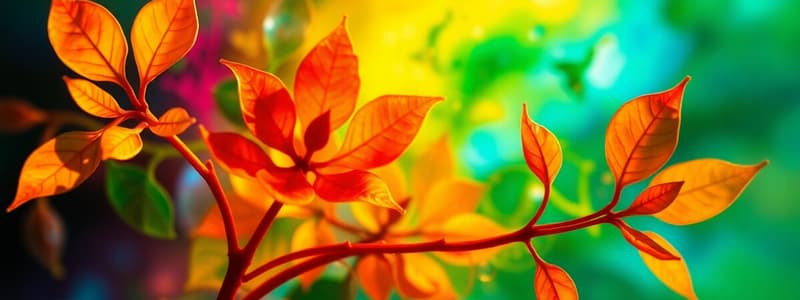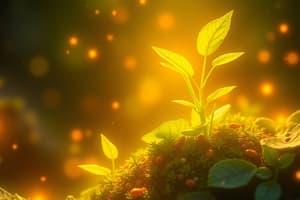Podcast
Questions and Answers
What occurs during the light-dependent stage of photosynthesis?
What occurs during the light-dependent stage of photosynthesis?
- Carbon fixation
- Splitting of water molecules (correct)
- Production of ribulose bisphosphate
- Synthesis of glucose
Which complex is responsible for the photolysis of water?
Which complex is responsible for the photolysis of water?
- Photosystem I
- Electron transport chain
- Photosystem II (correct)
- ATP synthase
What is the outcome of the reaction 2H2O → 4H+ + 4e− + O2?
What is the outcome of the reaction 2H2O → 4H+ + 4e− + O2?
- Formation of ATP
- Production of glucose
- Release of oxygen (correct)
- Reduction of NADP
Which process describes how ATP is produced during the light-dependent reactions?
Which process describes how ATP is produced during the light-dependent reactions?
What role do the electrons play once they are released from chlorophyll in PSII?
What role do the electrons play once they are released from chlorophyll in PSII?
What happens to the protons (H+) after they are released from water during photolysis?
What happens to the protons (H+) after they are released from water during photolysis?
Where do the electrons emitted from PSII ultimately end up?
Where do the electrons emitted from PSII ultimately end up?
How are protons allowed to move back into the stroma from the thylakoid space?
How are protons allowed to move back into the stroma from the thylakoid space?
Which component primarily absorbs light energy during the light-dependent reactions?
Which component primarily absorbs light energy during the light-dependent reactions?
What is the final product of the combination of electrons from PSI and protons from photolysis?
What is the final product of the combination of electrons from PSI and protons from photolysis?
What is the primary function of the chlorophyll in PSII during the photosynthesis process?
What is the primary function of the chlorophyll in PSII during the photosynthesis process?
What are the end products of the light-dependent stage of photosynthesis?
What are the end products of the light-dependent stage of photosynthesis?
What occurs during the Calvin cycle in the light-independent stage?
What occurs during the Calvin cycle in the light-independent stage?
What is the role of ATP in the Calvin cycle?
What is the role of ATP in the Calvin cycle?
Which of the following describes cyclic photophosphorylation?
Which of the following describes cyclic photophosphorylation?
What is the result of combining carbon dioxide with ribulose bisphosphate (RuBP)?
What is the result of combining carbon dioxide with ribulose bisphosphate (RuBP)?
What does triose phosphate (TP) primarily get used for in photosynthesis?
What does triose phosphate (TP) primarily get used for in photosynthesis?
Which of the following substances is produced in the light-independent reactions?
Which of the following substances is produced in the light-independent reactions?
During which part of photosynthesis does the enzyme rubisco function?
During which part of photosynthesis does the enzyme rubisco function?
What is a primary role of reduced NADP in photosynthesis?
What is a primary role of reduced NADP in photosynthesis?
Study Notes
Light-Dependent Stage
- Occurs only in the presence of light
- Energy from light is used to split water molecules and produce ATP and reduced NADP
- Two pathways: non-cyclic photophosphorylation and cyclic photophosphorylation
- Non-cyclic photophosphorylation
- Chlorophyll molecules in PSI and PSII absorb light energy
- Energy excites electrons, raising their energy level
- Chlorophyll is said to be photoactivated
- PSII contains an enzyme in the oxygen-evolving complex that splits water when activated by light
- Photolysis: splitting by light
- Water molecules are split into oxygen and hydrogen atoms
- Each hydrogen atom loses its electron to become a positively charged hydrogen ion (proton), H+
- Electrons from the hydrogen replace the electrons lost from chlorophyll in PSII
- Oxygen atoms from the water combine to form oxygen molecules, which diffuse out of the chloroplast and into the air around the leaf
- Equation for the reaction: 2H2O light 4H+ + 4e− + O2
- Electrons emitted from PSII are picked up by electron carriers (electron transport chain) in the membranes of the thylakoids
- As the electrons move along the chain they release energy
- Energy is used to actively transport protons across the thylakoid membrane into the space between the membranes
- High concentration of protons build up in the thylakoid space
- Protons move back into the stroma from the thylakoid space by facilitated diffusion through ATP synthases, by chemiosmosis.
- This process provides energy to cause ADP and inorganic phosphate to combine to make ATP (photophosphorylation)
- At the end of the electron carrier chain, electrons are picked up by PSI
- Electrons from PSI are passed along a different chain of carriers to NADP
- NADP also picks up protons (hydrogen ions) from the split water molecules
- NADP becomes reduced NADP
- Z- scheme
- Diagram that illustrates the light-dependant stage
- Shows the energy levels of electrons
- Follows the journey of an electron from a water molecule
- Taken up by PSII
- Energy is raised as chlorophyll in PSII absorbs light energy
- Loses some energy as it passes along the electron carrier chain
- Taken up by PSI
- Energy is raised again as chlorophyll in PSI absorbs light energy
- Becomes part of a reduced NADP molecule
- Cyclic photophosphorylation
- Alternative pathway for the electron emitted from PSI
- Electron is passed along the electron transport chain, then back to PSI
- ATP is produced through photophosphorylation
- No reduced NADP is produced
Light-Independent Stage
- Series of reactions that can take place even without light
- Uses ATP and NADP from the light-dependent stage to synthesize carbohydrates from carbon dioxide
- Known as the Calvin cycle
- Takes place in the stroma of the chloroplast
- Rubisco
- Enzyme found in the stroma
- Carbon dioxide diffuses into the stroma from the air spaces within the leaf
- Carbon dioxide enters the active site of rubisco, combining with ribulose bisphosphate (RuBP)
- Two 3C molecules of glycerate 3-phosphate (GP) are produced
- Carbon fixation: combination of carbon dioxide with RuBP
- Energy from ATP and hydrogen from reduced NADP are used to reduce GP to triose phosphate (TP)
- TP is the first carbohydrate produced in photosynthesis
- Most of TP is used to regenerate RuBP, allowing more Carbon dioxide to be fixed
- This process uses ATP
- Remaining TP is used to produce glucose or other organic substances the plant cell requires
- Includes polysaccharides (starch for energy storage, cellulose for making cell walls), sucrose for transport, amino acids for making proteins, lipids for energy storage, and nucleotides for making DNA and RNA
- Some of the GP is directly used to produce certain amino acids
Studying That Suits You
Use AI to generate personalized quizzes and flashcards to suit your learning preferences.
Description
Explore the light-dependent stage of photosynthesis where light energy is utilized to split water molecules and generate ATP and reduced NADP. This quiz covers the two pathways: non-cyclic and cyclic photophosphorylation, including the role of chlorophyll and the process of photolysis.




